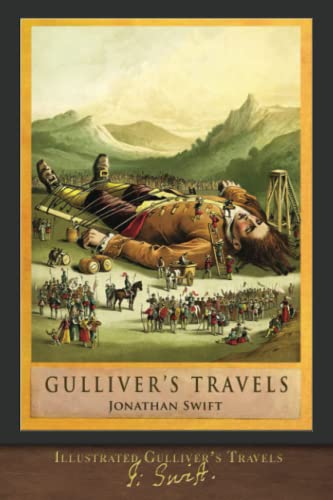If you ever wondered what it would feel like to wake up tied down by tiny people, or get attacked by giant wasps, then you should stick around—because this is my review of a book that has it all! Get ready for wacky adventures, weird creatures, and more satire than at a family dinner during election season. I’ve read this classic with my friends (and yes, some of them still think Lilliputians are just a type of nut), so buckle up as I spill the good, the bad, and the bonkers about Jonathan Swift’s weird and wild tale.
Gulliver’s Travels: A Quick Peek
In a nutsheel
If you like tales where people shrink, grow big, or end up on weird islands—this book is for you. Gulliver’s Travels comes from the mind of Jonathan Swift, a guy who saw the world and thought, “Hey, this needs more sarcasm!”
This story is a famous mix of adventure, fantasy, and big time satire. Swift uses wild journeys to poke fun at politics, science, and the odd ways people act. You’ll meet strange lands and even stranger folks, and at some point you might even wonder if Swift had something against regular-sized humans.
Themes include the silliness of society, human pride, and how people can miss the big picture (even when it’s right in front of them). But don’t worry—it’s not a boring lecture. It’s more like a sharp poke in the ribs from your cleverest friend. Whether you’re looking for laughs, adventure, or deep thoughts, this classic covers all the bases and then some.
Satire and Laughs: How ‘Gulliver’s Travels’ Pokes Fun at Everything
If you ever thought your government was silly, wait until you read ‘Gulliver’s Travels.’ Jonathan Swift puts on his clown shoes and marches through every chapter, poking fun at politics, science, and even the way people eat eggs. There’s a reason this book has stuck around for centuries, and it isn’t because it’s just another travel story. (Spoiler: it’s not!)
The story trots along from one ridiculous situation to the next. First up, we meet the tiny Lilliputians. These little folks are obsessed with where to crack an egg. You might think, “Hey, that’s not so crazy,” but Swift is rolling his eyes at the real political arguments of his own time. Next, in Brobdingnag, Gulliver gets squished and squashed by giants, and the tables turn: he’s now the little guy getting mocked. I read this part out loud to my friends, and everyone ended up laughing at poor Gulliver’s embarrassing moments—giant kittens, anyone?
Swift’s humor is sharp, but never too mean. He shows people how silly they can get when they let pride or politics go to their head. The best part? You don’t need a PhD to get the jokes. Anyone who’s ever felt small (or really, really tall) will find something to chuckle at. The only downside? Sometimes, the jokes go on a bit too long, and you might wish Gulliver would hurry up and get to the next silly place.
Next up, let’s see how all this funny business changes Gulliver’s mind about what it means to be human…get ready, it’s a wild ride!
Gulliver’s Shifting Thoughts on People in ‘Gulliver’s Travels’
Let me tell you, Gulliver starts out in ‘Gulliver’s Travels’ with a pretty normal view of people. He trusts folks, and thinks he has a good grip on what is right and wrong. At first, when he lands among the tiny Lilliputians, he still holds onto his old ideas. He keeps comparing these new, small people to his own countrymen. This works for a while, but then things start to get real weird. Gulliver spends more time away from home, and let me say, too much time away from your own kind makes you think!
By the time Gulliver ends up with the big, giant Brobdingnagians, he’s not so sure anymore. Imagine trying to talk about your country’s greatness while the giant king laughs right in your face! This moment hits hard for Gulliver. He starts doubting his own world. Is his own country really that great? Or does it just seem small, like a Lilliputian?
And then, after a few more stops, Gulliver meets the Houyhnhnms—horses who act more like people than actual people do. By now, poor Gulliver is a mess. He starts loving horses more than humans. By the end, he can’t even look at his own family without thinking, “These people are just Yahoos!”
Next up, we’ll gallop over to the wild and wacky creatures Gulliver meets—get ready for some serious beastly business!
Weird and Wonderful Creatures in Gulliver’s Travels
Let’s talk about the real stars of Gulliver’s Travels: its bonkers creatures. Jonathan Swift must have had a wild time making these up. First, you meet the Lilliputians. These are tiny little folks, about six inches tall. Imagine my disappointment when I realized they can’t fix my leaky sink. They tie Gulliver down with sewing thread and basically treat him like a walking mountain. I kept picturing myself tripping over their teeny houses.
But wait, it gets weirder. Later, Gulliver meets the Brobdingnagians. This lot are giants, and suddenly Gulliver is the size of a bug. I’d last two minutes in that place, and probably end up as a giant’s pet hamster. Swift does a great job showing how size changes your whole outlook—literally. Next up, the Laputans, floating around on a flying island. They’re obsessed with math and music but can’t hammer a nail straight. Honestly, it’s like if my cousins became rulers.
Just when you think Swift has run out of steam, enter the Houyhnhnms. These are wise, talking horses. Their neighbors, the Yahoos, are basically wild, jerky humans. The horses act more civil than most people at a family reunion. The contrast makes you wonder who the real animals are, and if you’ve ever neigh’ed by accident.
In short, Gulliver’s Travels throws some wild creatures at you, each weirder (and funnier) than the last. It keeps you guessing what (or who) Gulliver will bump into next. Stay tuned—the next section will get into the book’s writing style and if it’s as readable as a restaurant menu on Taco Tuesday.
Writing Style and Readability: Gulliver’s Travels Unpacked
Let’s talk about the way Jonathan Swift puts words on the page in Gulliver’s Travels. Swift does not write like your best mate who texts you memes. His sentences sometimes stretch out like they’ve been doing yoga, and the words he picks are about as old school as a floppy disk. Reading this book, you might have to pause now and then, scratch your head, and ask, “Did people really talk like this?”
The book is broken up into different parts, and each section has its own mood. Sometimes it’s funny, other times it’s grumpy. The narrator, Gulliver, loves to describe everything he sees. And I mean everything. Chairs, eggs, even the weird noises people make—nothing gets past this guy. Personally, I found this both charming and, at times, as slow as my grandma’s dial-up internet.
One thing I really like: Swift manages to sneak in jokes, even when he’s being serious. You might miss them if you’re not paying attention. I once read a page aloud to my friend Dave and he laughed so hard he snorted tea. The downside is, the language can feel pretty heavy. If you’re allergic to old words or long sentences, you might need an allergy pill before starting.
But here’s the thing: once you get into the rhythm, the story is worth chewing through. I say give Gulliver’s Travels a shot if you want a classic with a bit of a workout for your brain. You won’t regret it, unless you hate fun and adventure. And who hates those?
Conclusion
Well, that’s it folks. This was my wild ride through Gulliver’s Travels. Jonathan Swift sure knew how to poke fun at the world. The book is smart, silly, and packed with strange creatures—kind of like my friends after too much pizza. While some old words may slow you down, the laughs and deeper ideas make it worth it. If you like your books with a side of weird and a heap of honesty, give this classic a try. This concludes my review. Now go, impress someone with your knowledge of tiny people and talking horses!


